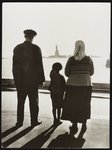Join us for conversations that inspire, recognize, and encourage innovation and best practices in the education profession.
Available on Apple Podcasts, Spotify, Google Podcasts, and more.


[IMMIGRANT FAMILY LOOKING AT STATUE OF LIBERTY FROM ELLIS ISLAND] (ca. 1930) courtesy of Library of Congress [LC-USZ62-50904].
We’re used to hearing about “illegal immigration” in the U.S. today. Emotions run high as people attack and defend modern immigration to the U.S.
All this clamor can hide the fact that this is really the first time in U.S. history that there has been a problem called “illegal immigration.” Yes, Chinese immigration was halted by the Chinese Exclusion Act of 1882, and the “Gentlemen’s Agreement” of 1907 allowed the U.S. to stop Japanese immigration by having Japan outlaw emigration. And the Immigration Act of 1924 was an attempt to sharply lower the number of Jewish, Catholic, and Asian immigrants entering the country.
But the very success of these measures meant there were no “illegal immigrants” in those periods. Unwanted groups were effectively kept out or their numbers lowered—they did not continue to enter the country in large numbers. The immigration “issue” was how to manage existing (legal) immigration populations.
Today, there are no groups targeted as “unwanted” in the way those earlier groups were: people from all nations are welcome to emigrate here—the only caveat is they must do it legally. But the definition of “doing it legally” has been fundamentally changed over the decades since WWII.
For the majority of our history it was just very easy to enter the U.S. legally. If you were not part of an “excluded” group, gaining permanent residence in the U.S. was simple and quick. There were no written exams. The tens of millions of people who came here through Ellis Island only had to have their name appear on their ship’s register and pass a physical exam so brief that the doctors giving it called it the “six-second exam.” Some had to show the address of a person already living in the U.S. who they could stay with. That’s it. Those immigrants were free to live the rest of their lives in America, and become citizens by passing a civics and history test.
That easy entry began to change after WWII. By the late 20th century, gaining permanent residence required a permanent visa, and citizenship required having a visa, a full-time employer who would pay to sponsor you, and other requirements that cost money, required good English skills, and took years of dedicated effort to fulfill.
This means that people today who claim that immigrants back then “followed the rules” while (illegal) immigrants today don’t are on pretty thin ice. When it’s easy to follow the rules, people do it. When getting into the U.S. legally is very difficult and expensive, people either don’t or can’t do it.
When you’re teaching the topic of immigration, consider discussing these points with students:
Engaging students in a conversation about the role of immigration in their families (past and present), in their town, in their state, and in their region is a good way into the topic. Everyone in your class is touched by immigration; if it is a politically charged topic in your school, town, or state, it’s important to look at the history of immigration in your area to see that new groups are often feared at first but find acceptance as time passes. This can help students see that immigration has often caused controversy but always improved our nation.
Most Americans don’t know a lot of facts about immigration past or present. For a historical overview, see American Passages, “Coming to America: Immigrants at Ellis Island.” For the present, go to the Statistical Portrait of the Foreign-Born Population in the United States, 1960-2013 by the Pew Research Center.
Additional Resources for Teaching About Controversial Topics:
“Should schools allow discussions of controversial issues?”
The Learning Classroom: Theory Into Practice, session 5, “Feelings Count- Emotion and Learning”
Social Studies in Action, “Dealing With Controversial Issues“